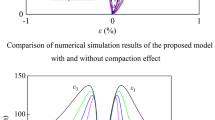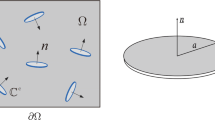Abstract
As a type of pyroclastic rock, the breccia lava in the dam foundation of the Baihetan Hydropower Project is characterized by relatively low density, high natural moisture content and porosity, and lower ultrasonic velocity. When it is used as a bearing rock, its mechanical behavior will be critical for the safety and stability of the world’s second largest hydropower station. Therefore, uniaxial and triaxial compression tests were performed to study the mechanical behavior of the breccia lava and scanning electron microscope (SEM) tests were carried out to reveal the microscopic failure modes of this rock. The experimental results indicated that all critical stresses, including the crack initiation stress (σci), crack damage stress (σcd), and peak stress (σp), exhibit strong dependence on the confining pressure. Experiential functions were used to describe the evolution of the elastic modulus and Poisson’s ratio with confining pressure. Grain crushing and the growth and frictional sliding of microcracks were determined to cause the failure of the specimens. Based on the experimental results, a coupled elastoplastic damage model was proposed within a thermodynamic framework. In this model, two separate loading functions were employed to describe the damage and plasticity behavior of the breccia lava. A computational integration algorithm with high numerical accuracy and efficiency was developed to deal with the material under three different loading conditions: plasticity, damage, and coupled elastoplastic damage. The model was validated through comparison with the experimental data, and the good agreement between the two datasets confirms that the model can provide a good representation of mechanical behavior, particularly the post-peak behavior of the breccia lava.











Similar content being viewed by others
References
Bieniawski ZT (1967) Mechanism of brittle rock fracture. Part I. Theory of the fracture process. Int J Rock Mech Min Sci 4:395–406
Brace WF (1964) Brittle fracture of rocks. In: Judd WR (ed) State of stress in the Earth's crust, proceeding of the international conference. American Elsevier Publishing Company, Santa Monica
Cai M, Kaiser PK, Tasaka Y, Maejima T, Morioka H, Minami M (2004) Generalized crack initiation and crack damage stress thresholds of brittle rock masses near underground excavations. Int J Rock Mech Min Sci 41:833–847. https://doi.org/10.1016/j.ijrmms.2004.02.001
Chang SH, Lee CI, Lee YK (2007) An experimental damage model and its application to the evaluation of the excavation damage zone. Rock Mech Rock Eng 40:245–285. https://doi.org/10.1007/s00603-006-0113-8
Chen L, Wang CP, Liu JF, Liu J, Wang J, Jia Y, Shao JF (2014) Damage and plastic deformation modeling of Beishan granite under compressive stress conditions. Rock Mech Rock Eng 48:1623–1633. https://doi.org/10.1007/s00603-014-0650-5
Chiarelli AS, Shao JF, Hoteit N (2003) Modeling of elastoplastic damage behavior of a claystone. Int J Plast 19:23–45. https://doi.org/10.1016/S0749-6419(01)00017-1
Dahou A, Shao J, Bederiat M (1995) Experimental and numerical investigations on transient creep of porous chalk. Mech Mater 21:147–158
Eberhardt E, Stead D, Stimpson B (1999) Quantifying progressive pre-peak brittle fracture damage in rock during uniaxial compression. Int J Rock Mech Min Sci 36:361–380. https://doi.org/10.1016/S0148-9062(99)00019-4
Eberhardt E, Stead D, Stimpson B, Read RS (1998) Identifying crack initiation and propagation thresholds in brittle rock. Can Geotech J 35:222–233. https://doi.org/10.1139/cgj-35-2-222
Fairhurst CE, Hudson JA (1999) Draft ISRM suggested method for the complete stress-strain curve for intact rock in uniaxial compression. Int J Rock Mech Min Sci 36:281–289
Grindrod PM, Heap MJ, Fortes AD, Meredith PG, Wood IG, Trippetta F, Sammonds PR (2010) Experimental investigation of the mechanical properties of synthetic magnesium sulfate hydrates: implications for the strength of hydrated deposits on Mars. J Geophys Res 115:E06012. https://doi.org/10.1029/2009je003552
Hansen N, Schreyer H (1994) A thermodynamically consistent framework for theories of elastoplasticity coupled with damage. Int J Solids Struct 31:359–389
Jia Y, Song XC, Duveau G, Su K, Shao JF (2007) Elastoplastic damage modelling of argillite in partially saturated condition and application. Phys Chem Earth 32:656–666. https://doi.org/10.1016/j.pce.2006.02.054
Jiang Q, Feng XT, Hatzor YH, Hao XJ, Li SJ (2014) Mechanical anisotropy of columnar jointed basalts: an example from the Baihetan hydropower station, China. Eng Geol 175:35–45. https://doi.org/10.1016/j.enggeo.2014.03.019
Liu XS, Ning JG, Tan YL, Gu QH (2016) Damage constitutive model based on energy dissipation for intact rock subjected to cyclic loading. Int J Rock Mech Min Sci 85:27–32. https://doi.org/10.1016/j.ijrmms.2016.03.003
Martin CD, Chandler NA (1994) The progressive fracture of Lac du Bonnet granite. Int J Rock Mech Min Sci 31:643–659. https://doi.org/10.1016/0148-9062(94)90005-1
Paterson MS, Wong T-F (2005) Experimental rock deformation-the brittle field. Springer Science & Business Media, Netherlands
Pensee V, Kondo D, Dormieux L (2002) Micromechanical analysis of anisotropic damage in brittle materials. J Eng Mech 128:889–897. https://doi.org/10.1061/(Asce)0733-9399(2002)128:8(889)
Shao JF, Jia Y, Kondo D, Chiarelli AS (2006) A coupled elastoplastic damage model for semi-brittle materials and extension to unsaturated conditions. Mech Mater 38:218–232. https://doi.org/10.1016/j.mechmat.2005.07.002
Shi A, Tang M, Zhou Q (2008) Research of deformation characteristics of columnar jointed basalt at Baihetan hydropower station on Jinsha river. Chin J Rock Mech Eng 27:2079–2086 [in Chinese]
Simo JC, Hughes TJ (1998) Computational inelasticity, volume 7 of interdisciplinary applied mathematics. Springer-Verlag, New York
Simo JC, Ortiz M (1985) A unified approach to finite deformation Elastoplastic analysis based on the use of Hyperelastic constitutive-equations. Comput Methods Appl Mech Eng 49:221–245. https://doi.org/10.1016/0045-7825(85)90061-1
Sirdesai NN, Mahanta B, Ranjith PG, Singh TN (2017a) Effects of thermal treatment on physico-morphological properties of Indian fine-grained sandstone. Bull Eng Geol Environ. https://doi.org/10.1007/s10064-017-1149-6
Sirdesai NN, Singh TN, Pathegama Gamage R (2017b) Thermal alterations in the poro-mechanical characteristic of an Indian sandstone – a comparative study. Eng Geol 226:208–220. https://doi.org/10.1016/j.enggeo.2017.06.010
Sirdesai NN, Singh TN, Ranjith PG, Singh R (2016) Effect of varied durations of thermal treatment on the tensile strength of red sandstone. Rock Mech Rock Eng 50:205–213. https://doi.org/10.1007/s00603-016-1047-4
Song Z, Liu Y, Yang Q (2016) Experimental and numerical investigation on the stability of a high arch dam with typical problems of nonsymmetry: Baihetan Dam, China. Bull Eng Geol Environ 75:1555–1570
Tapponnier P, Brace W (1976) Development of stress-induced microcracks in westerly granite. Int J Rock Mech Min Sci 13:103–112
Vermeer PA, De Borst R (1984) Non-associated plasticity for soils, concrete and rock. Heron 29:3–64
Wang HL, Xu WY, Shao JF (2014) Experimental researches on hydro-mechanical properties of altered rock under confining pressures. Rock Mech Rock Eng 47:485–493. https://doi.org/10.1007/s00603-013-0439-y
Wang S, Xu W, Jia C, Wang W (2017) Mechanical behavior of fine-grained sandstone in triaxial compression and elastoplastic modeling by return mapping algorithms. Bull Eng Geol Environ:1–11 https://doi.org/10.1007/s10064-017-1094-4
Weng MC, Jeng FS, Hsieh YM, Huang TH (2008) A simple model for stress-induced anisotropic softening of weak sandstones. Int J Rock Mech Min Sci 45:155–166. https://doi.org/10.1016/j.ijrmms.2007.04.004
Wong TF, David C, Zhu WL (1997) The transition from brittle faulting to cataclastic flow in porous sandstones: mechanical deformation. J Geophys Res-Solid Earth 102:3009–3025. https://doi.org/10.1029/96jb03281
Xiao Y-X, Feng X-T, Feng G-L, Liu H-J, Jiang Q, Qiu S-L (2016) Mechanism of evolution of stress–structure controlled collapse of surrounding rock in caverns: a case study from the Baihetan hydropower station in China. Tunn Undergr Space Technol 51:56–67
Xu WY, Wang RB, Wang W, Zhang ZL, Zhang JC, Wang WY (2012) Creep properties and permeability evolution in triaxial rheological tests of hard rock in dam foundation. J Cent S Univ Technol 19:252–261. https://doi.org/10.1007/s11771-012-0999-0
Xu X (2012) Research on rock mass mechanical characteristics and stability of high slope of Baihetan Hydropower Station. Chengdu University of Technology, Chengdu
Yan DX, Xu WY, Zheng WT, Wang W, Shi AC, Wu GY (2011) Mechanical characteristics of columnar jointed rock at dam base of Baihetan hydropower station. J Cent S Univ Technol 18:2157–2162. https://doi.org/10.1007/s11771-011-0957-2
Yang CH, Daemen JJK, Yin JH (1999) Experimental investigation of creep behavior of salt rock. Int J Rock Mech Min Sci 36:233–242. https://doi.org/10.1016/S0148-9062(98)00187-9
Yang S-Q, Xu P, Li Y-B, Huang Y-H (2017) Experimental investigation on triaxial mechanical and permeability behavior of sandstone after exposure to different high temperature treatments. Geothermics 69:93–109. https://doi.org/10.1016/j.geothermics.2017.04.009
Yang SQ (2016) Experimental study on deformation, peak strength and crack damage behavior of hollow sandstone under conventional triaxial compression. Eng Geol 213:11–24. https://doi.org/10.1016/j.enggeo.2016.08.012
Zhang JC, Xu WY, Wang HL, Wang RB, Meng QX, Du SW (2016) A coupled elastoplastic damage model for brittle rocks and its application in modelling underground excavation. Int J Rock Mech Min Sci 84:130–141. https://doi.org/10.1016/j.ijrmms.2015.11.011
Zhang JC, Zhou SH, Xu XH, Fang LG (2013) Evolution of the elastic properties of a bedded argillite damaged in cyclic triaxial tests. Int J Rock Mech Min Sci 58:103–110. https://doi.org/10.1016/j.ijrmms.2012.09.008
Zhang W, J-p C, Liu C, Huang R, Li M, Zhang Y (2012) Determination of geometrical and structural representative volume elements at the Baihetan Dam site. Rock Mech Rock Eng 45:409–419
Zhang Y, Shao JF, Xu WY, Zhao HB, Wang W (2014) Experimental and numerical investigations on strength and deformation behavior of Cataclastic sandstone. Rock Mech Rock Eng 48:1083–1096. https://doi.org/10.1007/s00603-014-0623-8
Zhao LY, Zhu QZ, Xu WY, Dai F, Shao JF (2016) A unified micromechanics-based damage model for instantaneous and time-dependent behaviors of brittle rocks. Int J Rock Mech Min Sci 84:187–196. https://doi.org/10.1016/j.ijrmms.2016.01.015
Zheng YR, Gong XN (1989) Foundation of geotechnical plastic mechanics. China Architecture & Building Press, Beijing
Zhou CY, Zhu FX (2010) An elasto-plastic damage constitutive model with double yield surfaces for saturated soft rock. Int J Rock Mech Min Sci 47:385–395. https://doi.org/10.1016/j.ijrmms.2010.01.002
Zhu QZ (2016) Strength prediction of dry and saturated brittle rocks by unilateral damage-friction coupling, analyses. Comput Geotech 73:16–23. https://doi.org/10.1016/j.compgeo.2015.11.015
Acknowledgments
The research described in this paper was financially supported by the National Natural Science Foundation of China (grant nos. 11572110, 51479049, 51679069, and 51609070) and the Fundamental Research Funds for the Central Universities (grant no. 2016B05314), and the Qinglan Project is gratefully acknowledged.
Author information
Authors and Affiliations
Corresponding author
Rights and permissions
About this article
Cite this article
Jia, C., Xu, W., Wang, S. et al. Experimental analysis and modeling of the mechanical behavior of breccia lava in the dam foundation of the Baihetan Hydropower Project. Bull Eng Geol Environ 78, 2681–2695 (2019). https://doi.org/10.1007/s10064-018-1228-3
Received:
Accepted:
Published:
Issue Date:
DOI: https://doi.org/10.1007/s10064-018-1228-3




